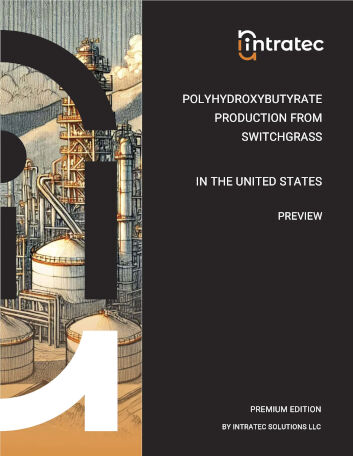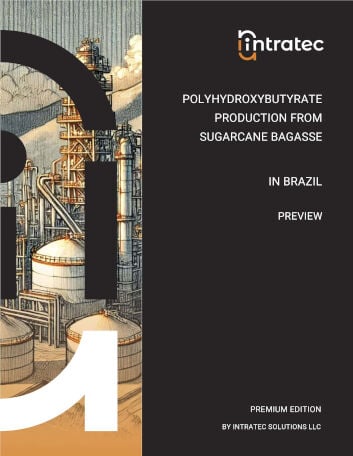Commodity Production Costs Report
Polyhydroxybutyrate Production from Sugarcane Bagasse
Polyhydroxybutyrate Plant Capital & Operating Cost Analysis | United States | Q3 2025
This report presents the economics of Polyhydroxybutyrate (PHB) production from sugarcane bagasse. The process examined is similar to one developed by Iowa State University. In this process, sugarcane bagasse is gasified to synthesis gas (syngas), which is fermented to PHB. Hydrogen is generated as by-product.
The report provides a comprehensive study of Polyhydroxybutyrate production and related Polyhydroxybutyrate production cost, covering three key aspects: a complete description of the Polyhydroxybutyrate production process examined; an in-depth analysis of the related Polyhydroxybutyrate plant capital cost (Capex); and an evaluation of the respective Polyhydroxybutyrate plant operating costs (Opex).
The Polyhydroxybutyrate production process description includes a block flow diagram (BFD), an overview of the industrial site installations, detailing both the process unit and the necessary infrastructure, process consumption figures and comprehensive process flow diagrams (PFD). The Polyhydroxybutyrate plant capital cost analysis breaks down the Capex by plant cost (i.e., ISBL, OSBL and Contingency); owner's cost; working capital; and costs incurred during industrial plant commissioning and start-up. The Polyhydroxybutyrate plant operating costs analysis covers operating expenses, including variable costs like raw materials and utilities, and fixed costs such as maintenance, labor, and depreciation.

Products
PHB. Polyhydroxybutyrate (a.k.a. PHB) is a biodegradable polymer synthesized by microorganisms. It belongs to the polyhydroxyalcanoate (PHA) group of polyesters and presents several similarities to conventional plastics. In addition, PHB is one of the few polyhydroxyalkanoates produced on a large scale for commercial exploitation.
Hydrogen. The hydrogen molecule, H2, is the normal state of pure hydrogen, even though hydrogen can be found in its atomic form under specific conditions. It is a very stable molecule, not usually reactive under normal conditions. Essentially, molecular hydrogen is produced industrially by three different methods: hydrocarbons steam reforming, hydrocarbons partial oxidation and water electrolysis. Hydrogen can also be obtained as a by-product recovered in processes such as the manufacture of styrene from ethylbenzene.
Raw Material
Sugarcane Bagasse. Sugarcane bagasse is the fibrous residue remaining after sugarcane stalks are crushed to extract juice. It is used as a biofuel, in paper production, and as a raw material for biodegradable composites. Collected from sugar mills, bagasse is stored in piles or bales. Its utilization contributes to waste reduction and renewable energy generation, supporting sustainable agricultural practices.
Report in PDF Format
Download & Explore Anytime
Access in Various Devices
Print & Read Comfortably
Share With Co-workers
Up-to-date Report
Professional report based on Q3 2025 economic data, ensuring timely evaluations.
Multiple Use Cases
Ideal for investment screening, feasibility studies, cost estimates, and research planning.
Proven Methodology
Developed using a consistent methodology honed over a decade, ensuring reliable cost analyses.
Report Editions
Content Highlights
Plant Capital Cost Summary
Summary outlining the capital cost required for building the Polyhydroxybutyrate production plant examined.
Plant Capital Cost Details
Detailing of fixed capital (ISBL, OSBL & Owner’s Cost), working capital and additional capital requirements.
Plant Cost Breakdowns
Breakdown of Polyhydroxybutyrate process unit (ISBL) costs and infrastructure (OSBL) costs; plant cost breakdown per discipline.
Operating Costs Summary
Summary presenting the operating variable costs and the total operating cost of the Polyhydroxybutyrate production plant studied.
Operating Cost Details
Detailing of utilities costs, operating fixed costs and depreciation.
Plant Capacity Assessment
Comparative analysis of capital investment and operating costs for different Polyhydroxybutyrate plant capacities.
Production Process Information
Block Flow Diagram, descriptions of process unit (ISBL) and site infrastructure (OSBL).
Process Consumptions
Raw materials and utilities consumption figures, by-products credits, labor requirements
Process Diagrams
Process flow diagrams (PFD), equipment list and industrial site configuration
Other Polyhydroxybutyrate Production Cost Reports

Polyhydroxybutyrate Production from Natural Gas
This study approaches the economics of Polyhydroxybutyrate (PHB) from natural gas in the United States. In the process examined, methane contained in the natural gas feedstock is fermented to Poly-3-hydroxybutyrate by a mixed methanotrophic culture of bacteria.
Details: 100 kta United States-based plant | Q3 2025 | 107 pages | Issue C | From $799 USD

Polyhydroxybutyrate Production from Switchgrass
This report presents the Economic analysis of Polyhydroxybutyrate (PHB) production from switchgrass. In this process, switchgrass is gasified to synthesis gas (syngas), which is fermented to PHB. The economic analysis presented is based on a plant constructed in the United States.
Details: 10 kta United States-based plant | Q3 2025 | 107 pages | Issue A | From $1,199 USD
Bundle & Save
Purchase multiple Polyhydroxybutyrate Production Cost reports and enjoy tiered discounts
up to 20% off!
Could Not Find the Report You Need?
Obtain a Bespoke Report
Get a report targeting the process in which you are interested
See Offer Details
Understand Bespoke Reports and how you can easily order them
Check Editions & Pricing
Complete a brief form and see a quotation for your Bespoke Report
Other Related Production Cost Reports

Ethanol from Sugarcane Bagasse (Digestion with SO2-Ethanol-Water Solution)
This report approaches the economics of second generation Ethanol production from sugarcane bagasse in Brazil using a biochemical conversion process similar to AVAP technology, developed by American Process. In this process, biomass is fractionated into cellulose, hemicelluloses and lignin by using a sulfur dioxide-ethanol-water solution. The cellulose and hemicelluloses obtained from biomass are converted to monomeric sugars, which are then used to produce Ethanol via fermentation.
Details: 80 kta Brazil-based plant | Q3 2025 | 107 pages | Issue J | From $799 USD

Ethanol from Sugarcane Bagasse (Hemicelluloses Extraction)
This feasibility study provides the economic analysis of second generation Ethanol production from sugarcane bagasse in Brazil. The process examined is similar to GreenPower, also developed by American Process. In this process, only hemicelluloses are extracted from biomass and are used to produce hydrous Ethanol via fermentation of monomer sugars.
Details: 80 kta Brazil-based plant | Q3 2025 | 107 pages | Issue M | From $799 USD
+800 Reports Developed, Targeting +250 Commodities
Vast Report Library
858 independent and up-to-date reports examining embryonic and established production processes.
Free Sample Reports
Quickly understand the structure and depth of content of our professional reports.

